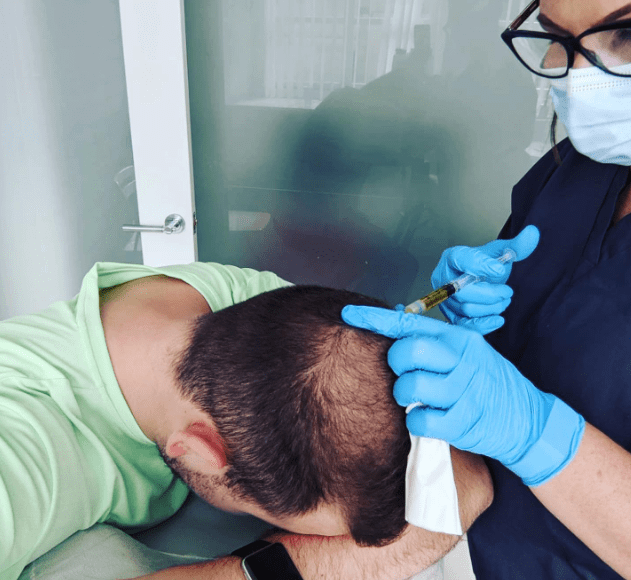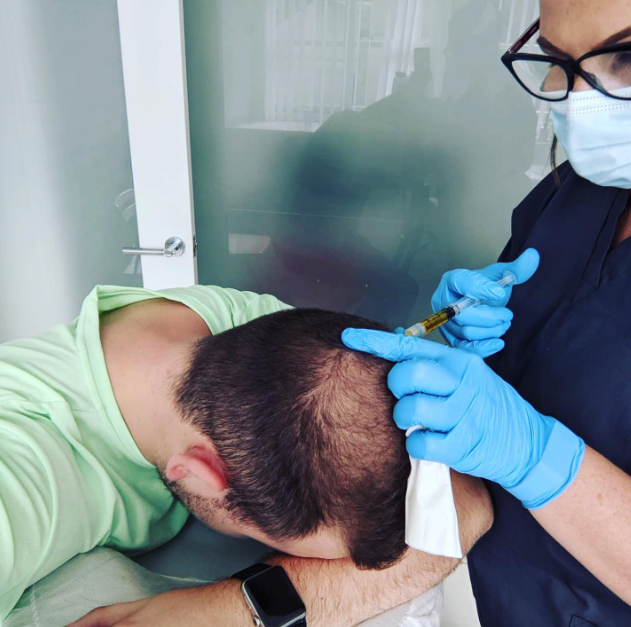
How Much Time is Allowed to Wear a Hat After Hair Transplant?

A Patient at Merchant City Medical Group
Are you considering to have a hair transplant soon?
Do you like to rock a hat?
It can be very tempting to wear a hat following hair transplant surgery. You would prefer not to display yourself in public with the numerous puncture marks from the removed and transplanted follicles covering your head.
For many, the choice to wear a hat is comforting. It shields against the initial scabbing and redness that can be part of the recovery process. It’s a way to maintain your privacy and comfort during this time.
A hat is important since it protects the scarred areas against sun exposure. Before you decide to cover up your new hair restoration with a hat, it’s crucial to understand that patience is key. Waiting for your scalp to fully heal is an important step in recovery.
Here are guidelines for wearing a hat over the transplanted area and related guidelines.
Why are Hats Important After a Hair transplant?
After a hair transplant, hats become your best friend! Think of them as your stylish shield.
Let’s get into their importance.
Hats Act as Shield Against the Sun Exposure
UV rays can burn skin and harm the tissue that repairs on the scalp. Because of this, surgeons recommend that patients with hair transplants stay out of the sun following their procedure. You may protect your scalp from damaging rays by donning a hat or applying sun protection. For guidance on the best sun cream following your hair transplant, speak with your surgeon.
Does Sun Exposure Impact Hair Transplants?
Indeed, hair transplants may be significantly impacted by the UV photons that the amount emits.
Your hair transplant’s success may be lowered by exposure to direct sunshine.
Why Does it Matter That You Avoid the Sun After Getting a Hair Transplant?
Following a hair transplant procedure, the transplanted hair follicles are still fragile, and your skin is extremely sensitive. The skin’s capacity to defend against UV damage diminishes after a transplant.
Deeper solar damage is easily attainable by sensitive skin near the donor and transplant sites. Furthermore, prolonged sun exposure may have an impact on transplanted hair follicles. Because of this, it’s critical to avoid the sun following a hair transplant.
After a Hair Transplant Procedure, How Soon May I Wear a Hat?
When may I wear a hat after getting a hair transplant?
This is one of the most frequent queries most patients have.
During the first few days after the hair transplant, you may experience bleeding and scabbing, and your scalp might be inflamed. You may feel at ease hiding the hair transplant by covering your scalp. However, until the grafts are properly attached, expert surgeons advise waiting seven to ten days before wearing anything over the scalp.
The grafts can become displaced, injured, or crushed if you wear a helmet. Injuring the grafts could lead to empty spots on the scalp and endanger the healing process for the overall hair transplant.
What Happens When You Wear a Hat after Getting a Hair Transplant?
As part of your post-transplant recovery process, your hair follicles must “anchor” themselves to their new places on the scalp. This can take up to ten days, with the first three being the most essential. Any form of early tugging or compression might damage the hair follicles, preventing new hair from growing in that area.
Wearing a helmet, especially a tight-fitting hat, might induce tugging and pushing on the transplanted areas, potentially dislodging some of the grafts. This, in turn, may result in bald patches forming in those locations later on once your growth cycles begin. To avoid this, it is essential that you strictly adhere to all post-op recommendations regarding hat-wearing.
This may seem counterintuitive, but clothing is no exception. Avoid wearing tight-fitting items like sweaters for the first week after your hair transplant. Instead, wear zip-up jackets or button-up shirts.
Let’s look at the healing timeline after a hair transplant. Shall we?
The Hair Transplant Healing Process and Timeline
What is the healing timeline like after a hair transplant?
This is important to know especially if you are curious about when to wear your hat after the hair transplant.
Stage 1 – Initial Recovery (Days 1–4)
In this first stage, it’s advisable to concentrate on wound healing and infection control.
Your scalp may be sensitive, causing redness, swelling, and scabbing.
Stage 2 – Establishment of Blood Supply (Days 5-7)
In this stage, the transplanted hair grafts create a blood supply known as revascularization.
Your scalp’s substantial recuperation continues, indicating a promising step toward incorporating new hair.
Stage 3 – Shedding Phase (Days 10-21)
Transplanted hair sheds naturally to promote new growth. During this period, the follicle roots remain dormant before creating new hair, while the old ones fall out.
During Stage 4 – New Hair Growth (Week 3 forward)
You may notice new hair growth after three weeks of the procedure. However, significant growth may take several months. Understanding the different stages of the healing process will help you determine when wearing a hat following a hair transplant is acceptable.
Generally, it is best to wait until after the earliest stages of healing and blood supply establishment, which normally occur around the end of the first week, before considering wearing a hat.
How many days should one wait?
How Soon Can I Wear A Hat Following a Hair Transplant? Procedure?
Most patients want to know how soon they can wear a hat after a hair transplant. The scalp may swell after the hair transplant, and you may have bleeding and scabbing for the first few days. During this time, you may find it convenient to cover your scalp to conceal the hair transplant.
However, physicians recommend waiting 7 to 10 days before applying anything to the scalp until the grafts are properly fixed.
Wearing a hat increases the chance of grafts being crushed, injured, or displaced.
Damaging the grafts could result in empty spots on the scalp, jeopardising the entire hair transplant recovery process.
Wearing a hat after 7 to 10 days, when the grafts have been securely attached, is safe.
Are There Other Ways to Cover the Scalp After a Hair Transplant?
Your surgeon will advise you to wait at least ten days before wearing hats or other head accessories. If you still want to protect your scalp, your surgeon recommends wearing a loose, easily adjustable hood or hat.
Your doctor can recommend the best hat for you, and it is also wise to choose appropriate apparel. Avoid wearing or removing clothing that requires pulling them over your head. Instead, consider tops with front zips or buttons.
What Precautions Should be Taken While Wearing a Headpiece?
When wearing or removing your hat, ensure it does not come into contact with the implanted grafts.
- Take all appropriate care to avoid damaging the implanted grafts. Wear soft fabric headpieces.
- Cotton should be avoided because it tends to adhere to the scalp. Check that your hat is clean before wearing it.
- If your hat becomes stained with dirt or blood, wash it well to avoid infection.
- Also, avoid wearing the hat or any other headpiece for 5-6 hours daily.
- To achieve the best outcomes from your hair transplant, you must adhere to all aftercare instructions and recommendations provided by your surgeon.
Why Does Wearing a Hat Too Soon Cause Damage?
Wearing a hat too soon after a hair transplant is risky because the scalp and newly transplanted hair follicles are still healing.
Any premature straining or compression from a hat might harm these follicles, impeding new hair growth in those areas.
This phase of fragility necessitates sensitive care to get the best possible results from the transplant process.
– Compression on Hair Follicles
Wearing a helmet right after the treatment can strain the fragile hair follicles, compromising their placement and healing.
– Reduced Blood Flow
Tight caps can reduce blood flow to the scalp, which is necessary to nourish newly transplanted follicles and promote healthy hair growth.
– Risk of Infection
Hats can trap heat and moisture on the scalp, producing an environment ideal for bacterial growth and raising the risk of illness.
– Interference with Natural Healing
The scalp needs air and a soft environment to recover effectively; covering it with a hat too soon will stymie this natural healing process.
Why Do Some People Wear Headbands After a Hair Transplant?
Headbands are sometimes suggested after a hair transplant surgery to decrease swelling and bruises while protecting the scalp from the environment. Some surgeons recommend wearing a headband for a few days after surgery. However, this is not a required practice for all patients. Furthermore, headbands might absorb any fluids leaking from the recipient area during the first recovery period.
Take Away Point
Wearing a hat after a hair transplant is crucial to healing because it protects your new hair from sun exposure and other environmental variables. However, you must take the necessary measures when wearing headwear, such as avoiding tight-fitting caps and adopting lightweight materials whenever possible.
By following these guidelines and caring for your scalp, you will reap all the benefits of wearing a hat without sacrificing results.
For your hair transplant needs, the Merchant City Medical Group is here for you.
Who are we?
Our clinics in the UK stand out and provide both surgical and non-surgical cosmetic procedures. Thousands of men and women have benefited from our cutting-edge techniques and equipment because we care about their preferences.
Take action today, book your free consultation with us and get your desired look today.

